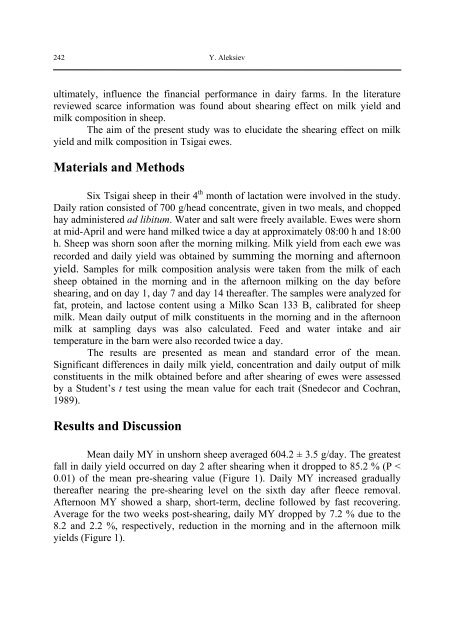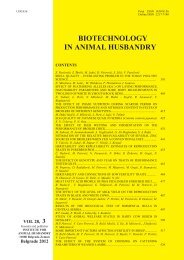Biotechnology in Animal Husbandry - Institut za Stočarstvo
Biotechnology in Animal Husbandry - Institut za Stočarstvo
Biotechnology in Animal Husbandry - Institut za Stočarstvo
You also want an ePaper? Increase the reach of your titles
YUMPU automatically turns print PDFs into web optimized ePapers that Google loves.
242<br />
Y. Aleksiev<br />
ultimately, <strong>in</strong>fluence the f<strong>in</strong>ancial performance <strong>in</strong> dairy farms. In the literature<br />
reviewed scarce <strong>in</strong>formation was found about shear<strong>in</strong>g effect on milk yield and<br />
milk composition <strong>in</strong> sheep.<br />
The aim of the present study was to elucidate the shear<strong>in</strong>g effect on milk<br />
yield and milk composition <strong>in</strong> Tsigai ewes.<br />
Materials and Methods<br />
Six Tsigai sheep <strong>in</strong> their 4 th month of lactation were <strong>in</strong>volved <strong>in</strong> the study.<br />
Daily ration consisted of 700 g/head concentrate, given <strong>in</strong> two meals, and chopped<br />
hay adm<strong>in</strong>istered ad libitum. Water and salt were freely available. Ewes were shorn<br />
at mid-April and were hand milked twice a day at approximately 08:00 h and 18:00<br />
h. Sheep was shorn soon after the morn<strong>in</strong>g milk<strong>in</strong>g. Milk yield from each ewe was<br />
recorded and daily yield was obta<strong>in</strong>ed by summ<strong>in</strong>g the morn<strong>in</strong>g and afternoon<br />
yield. Samples for milk composition analysis were taken from the milk of each<br />
sheep obta<strong>in</strong>ed <strong>in</strong> the morn<strong>in</strong>g and <strong>in</strong> the afternoon milk<strong>in</strong>g on the day before<br />
shear<strong>in</strong>g, and on day 1, day 7 and day 14 thereafter. The samples were analyzed for<br />
fat, prote<strong>in</strong>, and lactose content us<strong>in</strong>g a Milko Scan 133 B, calibrated for sheep<br />
milk. Mean daily output of milk constituents <strong>in</strong> the morn<strong>in</strong>g and <strong>in</strong> the afternoon<br />
milk at sampl<strong>in</strong>g days was also calculated. Feed and water <strong>in</strong>take and air<br />
temperature <strong>in</strong> the barn were also recorded twice a day.<br />
The results are presented as mean and standard error of the mean.<br />
Significant differences <strong>in</strong> daily milk yield, concentration and daily output of milk<br />
constituents <strong>in</strong> the milk obta<strong>in</strong>ed before and after shear<strong>in</strong>g of ewes were assessed<br />
by a Student’s t test us<strong>in</strong>g the mean value for each trait (Snedecor and Cochran,<br />
1989).<br />
Results and Discussion<br />
Mean daily MY <strong>in</strong> unshorn sheep averaged 604.2 ± 3.5 g/day. The greatest<br />
fall <strong>in</strong> daily yield occurred on day 2 after shear<strong>in</strong>g when it dropped to 85.2 % (P <<br />
0.01) of the mean pre-shear<strong>in</strong>g value (Figure 1). Daily MY <strong>in</strong>creased gradually<br />
thereafter near<strong>in</strong>g the pre-shear<strong>in</strong>g level on the sixth day after fleece removal.<br />
Afternoon MY showed a sharp, short-term, decl<strong>in</strong>e followed by fast recover<strong>in</strong>g.<br />
Average for the two weeks post-shear<strong>in</strong>g, daily MY dropped by 7.2 % due to the<br />
8.2 and 2.2 %, respectively, reduction <strong>in</strong> the morn<strong>in</strong>g and <strong>in</strong> the afternoon milk<br />
yields (Figure 1).




